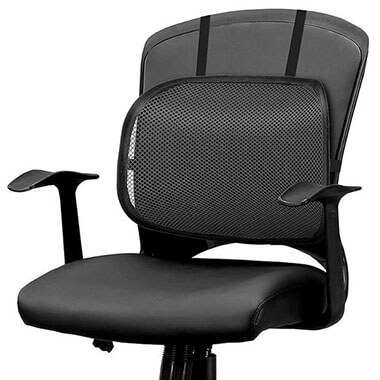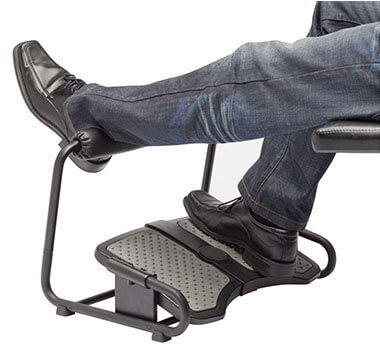Whether you’re working remotely or in the office, a not-so-ergonomic chair setup will manifest its ill effects sooner than later. Even with the right posture, spending long hours on an uncomfortable office chair can cause pain and aches and impair your productivity. So, how to make an office chair more comfortable?
While switching to a new, higher-quality chair is not always an option for all, there are a few tweaks you can make to improve the comfort of your office chair.
Once the chair height is on-point, extra items such as a lumbar support pillow, seat cushion, and footrest can make a difference to your sitting experience on the chair.
6 Ways to Make Your Chair More Comfortable
1. Proper Office Chair Height
We will start to puzzle out this question by looking at the chair height since it often determines how all your body parts, from head to toe, respond and allow you to sit upright while looking at the computer.

Office chairs commonly have built-in adjustments allowing you to customize seating position to your physique.
Your feet should be flat on the ground, while thighs and hips should form two 90-degree angles, and the knees also bend to create the same 90-degree angles. The correct chair height will let you sit straight up and read your monitor without leaning or bending.
Sitting in an incorrectly positioned chair for hours-long sessions can lead to an adverse impact on your entire body and overall health.
A too-high chair will render your legs handle off the ground. The gravity will pull them down further while the pelvis is leaning backward. Your core muscles need to work hard to balance off the tilting pelvis to keep yourself in an upright position.
Remaining in this position for an extended period will cause leg pain, numbness, and lack of blood supply to the back of the thighs.
On the other hand, sitting in a too-low chair will stress the hip joints, knees, hips, and ankle joints. This pressure can lead to discomfort and backaches with prolonged use.
2. Buy a Lumbar Support Pillow
A lumbar support pillow is often the differentiator between quality office chairs and ordinary ones.
If your office chair lacks this feature, you likely feel the lower back support is not right and find yourself sitting at the edge of the chair all the time. No worries, as this item is affordable, and you can buy one online hassle-free.

A lumbar support pillow serves as a bridge between your body and the chair back, enabling you to lean backward for the optimal typing position.
It has proven to provide much-needed comfort for those suffering lower back pain and prevent potential muscle sprains by correcting poor posture.
3. Add a Seat Cushion
Another culprit that makes your desk chair uncomfortable to sit in is the seat. You might feel it too firm, lack the supportive and comfortable padding, or right contours, and it’s a pain to plop down for a long time.

Placing a seat cushion on your office chair promotes the right posture and allows you to distribute your body mass evenly. It lifts the burden out of the hips and spines while facilitates healthy angles of the hips.
While seat cushions come in various shapes and sizes, we conclude that the ones with a cut-out and raised center works great to relieve the pressure on the tailbone and keeps your pelvis in its neutral position. These cushions are best companions for those with hip pain or herniated discs.
Make sure your cushions of choice do not retain heat, or you’ll feel sweaty and hot if sitting for hours on end. It’s worth spending a little extra for a model with a detachable and washable insert and cover. This feature will help your cushion look and smell as good as the first day.
After adding your seat cushion, re-adjust the chair height as the piece will add a few inches to the seat.
4. Try Armrest Pads
Never ignore your arms and hands since they constitute up to 10% of your body weight. If poorly supported or placed against a stiff armrest, these sections will suffer from pain sooner or later.

Armrests on lower-end chairs are often made of stiff plastic and not long enough to accommodate the entire forearms. It is advisable to furnish them with plushy pads so that your bones won’t sit directly on hard plastic or metal all day long.
Most armrest pads will easily wrap around your existing armrests to provide an extra cushion or extend to give more space for your forearms to rest on. Our recommended material for armrest pads is memory foam since it can contour to your arm and elbow’s shape.
5. Get a Footrest
Sometimes, getting your computer chair into the optimal ergonomic position for the upper part of the body can leave your feet struggling to reach the floor.
As we said earlier, this unhealthy posture will force your core muscles to work harder to maintain the upright position, leading to discomfort, strains, and pain over the long haul.

The solution is to give a footrest for your feet. Your makeshift footrest can be a pile of old books or a hard box as long as your feet can settle flat on a sturdy surface. Yet, a proper footrest will go a long way to keeping you sitting on the chair with comfort as long as possible.
Two common products are footrest pads and foot hammocks. Comfort is quite subjective when choosing a footrest pad since you might like a softer or harder feel. If you belong to the former league, we, again, recommend those pads made from memory foam.
Many pads can be adjusted to different heights and used at various angles or simply flat for the ultimate comfort. Under-desk feet hammock is another way to tackle the problem of dangling feet. It provides stable support but with extra flex to let your feet wiggle.
Like footrest pads, these hammocks also feature adjustable height to guarantee the best posture.
6. Change Your Sitting Posture
Followed all the solutions mentioned above but still struggle with muscle fatigue and back pain?
Chances are your situation has something to do with the sitting position. Poor sitting posture has been shown to cause lower back pain or worsen the existing conditions directly.

Adopting the proper posture is the key to a happy and healthy spine and back. The key body sections are aligned when sitting with the right posture, and your muscles are not overworking.
Avoid hunching over your desk, sitting slumped towards one side, or sitting in a way that is not fully supportive to the lower back. Plus, sitting with poorly supported feet or craning your neck either up and down to read the screen is also not advisable.
You can achieve a healthy sitting posture by:
- Sit up straight and look at the screen without tilting your head. You should add a headrest to the chair if not equipped.
- Place the knees level with your hips or slightly lower
- Position the knees and forearms parallel to the ground
- Keep the shoulders relaxed
- The back, especially the lower back, should meet the chair and comfortable lean against it
- Try to stop crossing ankles and knees
- Keep the feet flat on the floor
Even when sitting in the ideal position, it pays to move around occasionally to give all your muscles a break as well as refresh your mind.
Conclusion
Most of us spend an extended period sitting in front of the screen. Sitting in an uncomfortable office chair can be detrimental to your body and well-being in the long term.
We hope that our guide has been able to help you make your uncomfortable office chair more ergonomic and more comfortable. Upgrading to a higher-end chair is expensive yet not always better, so it should be your last port of call.
The first thing to check is the chair height, as it dictates how your head, neck, back, and legs work to keep you upright. Next, figure out where the discomfort comes from, whether it’s the strained lower back, sore forearms, or dangling feet, and tackle them one by one.






